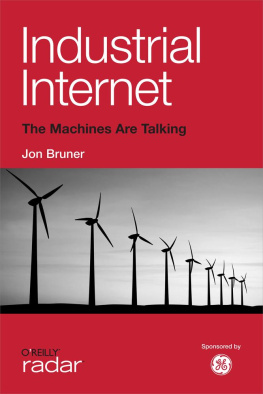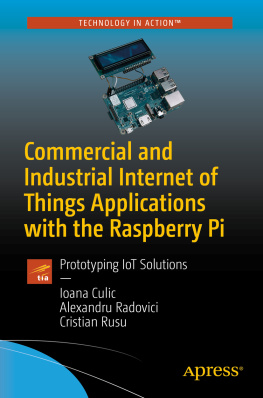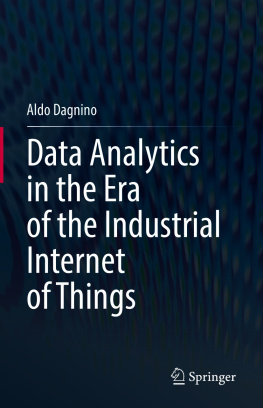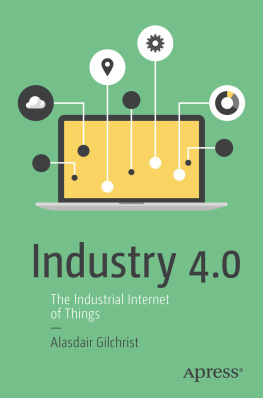Jon Bruner - Industrial Internet
Here you can read online Jon Bruner - Industrial Internet full text of the book (entire story) in english for free. Download pdf and epub, get meaning, cover and reviews about this ebook. year: 2013, publisher: O’Reilly Media, genre: Politics. Description of the work, (preface) as well as reviews are available. Best literature library LitArk.com created for fans of good reading and offers a wide selection of genres:
Romance novel
Science fiction
Adventure
Detective
Science
History
Home and family
Prose
Art
Politics
Computer
Non-fiction
Religion
Business
Children
Humor
Choose a favorite category and find really read worthwhile books. Enjoy immersion in the world of imagination, feel the emotions of the characters or learn something new for yourself, make an fascinating discovery.
- Book:Industrial Internet
- Author:
- Publisher:O’Reilly Media
- Genre:
- Year:2013
- Rating:5 / 5
- Favourites:Add to favourites
- Your mark:
- 100
- 1
- 2
- 3
- 4
- 5
Industrial Internet: summary, description and annotation
We offer to read an annotation, description, summary or preface (depends on what the author of the book "Industrial Internet" wrote himself). If you haven't found the necessary information about the book — write in the comments, we will try to find it.
Industrial Internet — read online for free the complete book (whole text) full work
Below is the text of the book, divided by pages. System saving the place of the last page read, allows you to conveniently read the book "Industrial Internet" online for free, without having to search again every time where you left off. Put a bookmark, and you can go to the page where you finished reading at any time.
Font size:
Interval:
Bookmark:

Beijing Cambridge Farnham Kln Sebastopol Tokyo
If you purchased this ebook directly from oreilly.com, you have the following benefits:
DRM-free ebooksuse your ebooks across devices without restrictions or limitations
Multiple formatsuse on your laptop, tablet, or phone
Lifetime access, with free updates
Dropbox syncingyour files, anywhere
If you purchased this ebook from another retailer, you can upgrade your ebook to take advantage of all these benefits for just $4.99. to access your ebook upgrade.
Please note that upgrade offers are not available from sample content.
I am grateful to more than 50 experts from the industries discussed in this report for speaking with me, hosting me on illuminating visits, and introducing me to their helpful contacts. Many of them gave me permission to share their insights here but asked that their names and affiliations not be published.
General Electric has generously underwritten this report, and it put its industry experts at my disposal while I wrote it. Nevertheless, the thematic development of the industrial internet in this report is strictly my own, formed from discussions with my colleagues at OReilly and outside experts.
Weve been developing our framing of the industrial internet since the fall of 2012, and we will continue to cover this space with blog posts, interviews, and videos at http://oreil.ly/industrial-internet.
Jon Bruner
The barriers between software and the physical world are falling. Its becoming easier to connect big machines to networks, to harvest data from them, and to control them remotely. The same changes in software and networks that brought about decades of Silicon Valley innovation are now reordering the machines around us.
Since the 1970s, the principles of abstraction and modularity have made it possible for practically anyone to learn how to develop software. That radical accessibility, along with pervasive networks and cheap computing power, has made it easy to create software solutions to information problems. Innovators have responded, and have reshaped practically any task that involves gathering information, analyzing it, and communicating the result.
Something similar is coming to the interfaces between software and the big machines that power the world around us. With a network connection and an open interface that masks its underlying complexity, a machine becomes a Web service, ready to be coupled to software intelligence that can ingest broad context and optimize entire systems of machines.
The industrial internet is this union of software and big machines what you might think of as the enterprise Internet of Things, operating under the demanding requirements of systems that have lives and expensive equipment at stake. It promises to bring the key characteristics of the Web modularity, abstraction, software above the level of a single device to demanding physical settings, letting innovators break down big problems, solve them in small pieces, and then stitch together their solutions.
The foundational technologies of the industrial internet are available now to anyone from big industrial firms to garage inventors. These technologies include: pervasive networks; open-source microcontrollers; software that can analyze massive amounts of data, understand human preferences, and optimize across many variables; and the computing power needed to run this intelligence, available anywhere at little cost.
Anyone who can recast physical-world problems into software terms now has access to the broad world of stuff that matters: conserving energy and reducing our impact on the environment; making our world safer, faster, and more comfortable; improving the productivity and well-being of workers; and generating economic opportunity.
The industrial internet[] is an approach to bringing software and machines together, not a particular group of technologies. These are the principles driving its development.
The industrial internet isnt necessarily about connecting big machines to the public Internet; rather, it refers to machines becoming nodes on pervasive networks that use open protocols. Internet-like behavior follows: machines publish data to authorized recipients and receive operational commands from authorized senders.
Think of the difference between an airplane built 40 years ago and a modern design like the Boeing 787. Older airplanes have direct linkages between systems from the landing-gear switch to the landing gear, for instance. Newer airplanes use standard networks, in which the landing gear is a node thats accessible to any other authorized part of the system not only the landing-gear switch, but also safety, autopilot, and data-logging systems. Software can understand the status of the airplane in its entirety and optimize it in real-time (and, with a data connection to dispatchers and the air-traffic control system, software can also understand the airplanes relationship to other planes and to the airspace around it).
The infrastructure of the Internet is highly flexible and scalable. Once a system of machines is brought together on a network, its easy to add new types of software intelligence to the system, and to encompass more machines as the scope of optimization expands.
Web services mask their underlying complexity through software interfaces. Need to convert an address to latitude and longitude? Googles geocoder API[] will make the conversion almost instantaneously, masking the complexity of the underlying process (text parsing, looking up possible matches in a database, choosing the best one). Geolocation thus becomes accessible to anyone building a Web site no expertise in cartography needed. These services become modules in Web applications, which are designed with minimal assumptions about the services they use so that a change or failure in one module wont break the entire application.
In the same way, the industrial internet presents machines as services, accessible to any authorized application thats on the network. The scope of knowledge needed to contribute to a physical-world solution becomes smaller in the process.
Making a furnace more efficient, for instance, might involve some combination of refining its mechanical and thermal elements (machine design) and making it run in better relation to the building its in and the occupants of that building (controls). The industrial internet makes it possible to approach these challenges separately: connect the furnace to a network and give it an API that guards against damaging commands, and the control problem becomes accessible to someone who knows something about software-driven optimization, but not much about furnaces.
In other words, the industrial internet makes the physical world accessible to anyone who can recast its problems in terms that software can handle: learning, analysis, system-wide optimization.
At the same time, this transfer of control to software can free machines to operate in the most efficient ways possible. Giving a furnace an advanced control system doesnt obviate the need for improvements to the furnaces mechanical design; a machine that anticipates being controlled effectively can itself be designed more efficiently.
Font size:
Interval:
Bookmark:
Similar books «Industrial Internet»
Look at similar books to Industrial Internet. We have selected literature similar in name and meaning in the hope of providing readers with more options to find new, interesting, not yet read works.
Discussion, reviews of the book Industrial Internet and just readers' own opinions. Leave your comments, write what you think about the work, its meaning or the main characters. Specify what exactly you liked and what you didn't like, and why you think so.












